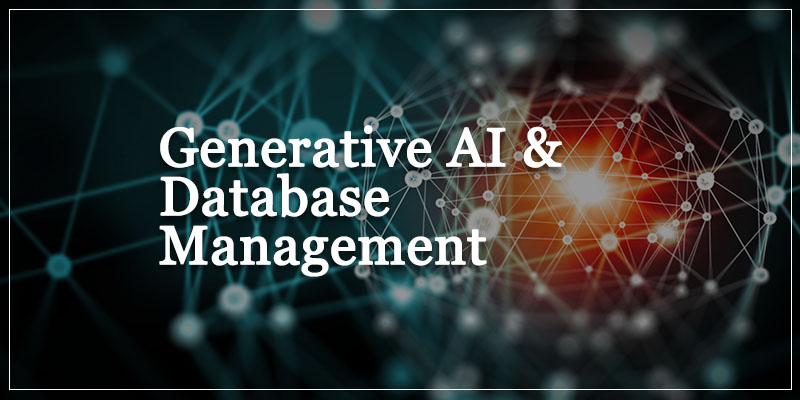The Possibilities and Boundaries of Generative AI in Database Management


Solutions Review’s Contributed Content Series is a collection of contributed articles written by thought leaders in enterprise technology. In this feature, EDB CTO Marc Linster offers commentary on the possibilities and pitfalls of generative AI in database management.
The realm of Generative AI, encompassing automated algorithms that craft, manipulate, and synthesize data, is poised to revolutionize the database landscape. This innovative approach, aptly named “generative” for its ability to create anew from historical data, has its origins traced back to the “ELIZA” chatbot of 1966, developed at MIT, a pioneering instance of generative AI. As the AI community anticipates a watershed moment in the integration of artificial intelligence into mainstream applications, there are still many questions that emerge about the extent of its capabilities and constraints. This includes whether generative AI will make it possible to launch an entire database instance simply by being asked by the user.
Generative AI & Database Management
Advanced Training AI
Initiating a database instance necessitates primarily the construction of a custom AI model that has undergone specialized training to craft and set up database instances. This training procedure entails utilizing an extensive dataset of pre-existing database configurations. The model’s proficiency lies in precisely scrutinizing and comprehending the prerequisites of a novel database instance.
Following this, Natural Language Processing (NLP) could be employed to enable users to commence a fresh database instance using natural language commands. Subsequently, the AI model would decipher the relevant instruction, generate a new database instance, and proceed to configure it according to the provided specifications.
The Necessity of Human Oversight
It’s important to recognize that constructing such a system demands substantial development skills and resources. Moreover, potential issues related to security and performance should be taken into account. Additionally, it’s worth noting that AI-generated database configurations might not always be optimal, thus requiring human review and validation.
Generative models like ChatGPT can already produce code as needed, like a Terraform template for deploying a PostgreSQL instance on AWS. However, it’s still prudent to closely monitor processes and outcomes. After all, technology doesn’t consistently perform exactly as anticipated. To guarantee that the aforementioned Terraform template executes correctly and that a security group isn’t inadvertently added, granting unrestricted access to the PostgreSQL port from the Internet, human supervision remains essential. While generative models offer significant time-saving potential, they haven’t yet reached a point of complete reliability. Handing over an API key to exclude human oversight from this process would be premature at this juncture.
The Role of Conversational AI in Database Problem Solving
Many wonder if ChatGPT can be utilized to identify issues in a database and suggest solutions. The key aspect to consider is that while Conversational AI can be valuable for diagnosing database problems, it shouldn’t be solely relied upon as the exclusive information source. Database issues can be intricate, and there might be aspects that AI cannot fully comprehend. Ensuring database security is of utmost importance. Any AI solution needs to be meticulously developed and integrated to prevent unintentional disclosure of sensitive data or the introduction of vulnerabilities into the database.
Workforce Training for Enhanced Security
To reduce this risk, companies need to adequately train and educate their staff. If an organization struggles to ensure secure scalability in the cloud using internal resources, collaborating with dependable third-party providers should be considered. Postgres is the world’s most “admired and desired” database by developers, according to the latest Stack Overflow 2023 Developer Survey, particularly if they are chosen for consistent security updates and bug fixes. This approach streamlines the code for users and significantly minimizes security vulnerabilities.
Challenges within databases can manifest in various ways, ranging from performance issues necessitating hardware upgrades and server reconfigurations, to tasks like indexing or statistics management. These issues might stem from hardware malfunctions, insufficient disk space, or other causes. While certain problems are straightforward to grasp, others can be intricate, demanding the expertise of experienced administrators.
Sophisticated Search Engines
Today’s generative models can be likened to sophisticated search engines. They can furnish responses based on the extensive data they’ve been trained on. However, even when the data is entirely accurate (which is unlikely), how can the model offer a valuable response if the person seeking assistance inadvertently leaves out crucial information?
In essence, the current state of this technology equips users with a helpful tool, yet it can’t replace human involvement. It might provide a suitable direct solution to a specific problem. More often, though, it can assist administrators in systematically narrowing down issues through an iterative approach.
Simplifying Database Management and Enhancing Performance
One of the most significant effects is streamlining database performance management and optimization. AI-driven tools can autonomously oversee databases, identify issues, and propose enhancements. This allows administrators to dedicate their time to more intricate tasks. Downtime is curtailed, leading to a marked enhancement in overall database dependability among other advantages including:
- Maximizing Benefits while Minimizing Risks: In the end, the strategic application of AI can harness its advantages while safeguarding individual privacy. Crucially, achieving this hinges on the collaboration of policymakers, industry leaders, and society as a whole. They need to collaborate in establishing suitable policies and practices that ensure the responsible utilization of AI technologies.
- Utilizing Generative Models as Useful Tools: Generative models prove valuable as tools. They contribute to generating Postgres data models, aiding in creating necessary schemas, or functioning as potent search engines for expedited problem-solving.
- The Evolution of Tools Leveraging Generative Models: In the forthcoming era, an increasing number of tools will utilize or integrate with generative models. Monitoring systems can rely on such models for intricate and automated supervision. These models can factor in elements like usage patterns and early warning indicators to predict potential issues. Management tools can incorporate interfaces for generating Postgres or initiating configurations rooted in well-known, high-performance setups for specific types of workloads.
In conclusion, generative models are not magical replacements for human tasks but rather tools that facilitate work. While they can enhance processes, it will take considerable time before they attain the required level of confidence, accuracy, and precision necessary for genuine autonomous system control.




















